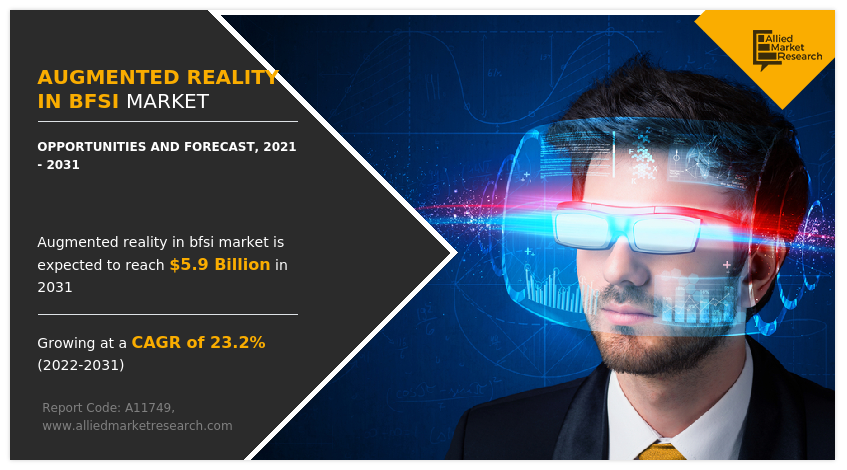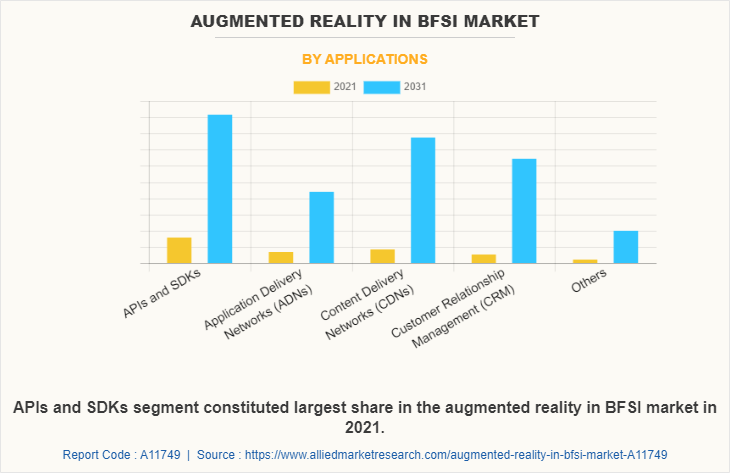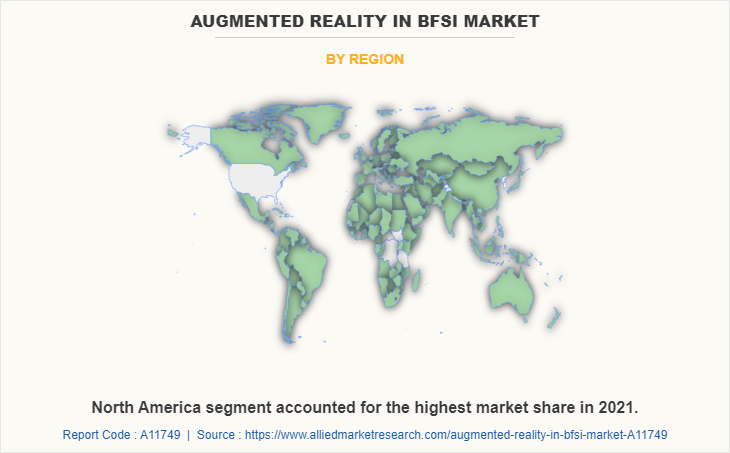Augmented Reality In BFSI Market Research, 2031
The global augmented reality in bfsi market was valued at $763.23 million in 2021, and is projected to reach $5.9 billion by 2031, growing at a CAGR of 23.2% from 2022 to 2031.
An interactive experience called augmented reality (AR) blends material created by computers with the physical environment. Visual, aural, tactile, somatosensory, and olfactory are just a few of the several sensory modalities that the content might use. A system that combines the actual and virtual worlds, allows for real-time interaction, and accurately registers 3D models of virtual and real items is known as augmented reality (AR). The sensory information that is being added on top of the environment might either be beneficial or harmful. The way that this experience is integrated into the real world creates the impression that it is an immersing part of it.

Augmented reality in BFSI helps to enhanced data visualization using augmented reality (AR). Also, most important aspect of utilizing AR technologies in the financial sector is the visualization of data. Moreover, advanced AR-backed stock trading and investing has created a way for participants to track and visualize the financial market with greater depth in a three-dimensional and interactive environment. In addition, there is a rising adoption of augmented reality in BFSI among the end user, because of the easy access to solutions and the opportunity to carry out whatever activities they want easily from anywhere across globe.
Therefore, these are some of the factors that propel the augmented reality in BFSI market growth. However, the cost of adopting Augmented reality in BFSI is high, which led difficulties for the small lenders to adopt the technology. In addition, small and medium enterprises are unable to adopt this technology because of its high cost. On the contrary, there is growing usage of AI in augmented reality in BFSI market, which helps to boost the market in the coming years.
The report focuses on growth prospects, restraints, and trends of the augmented reality in BFSI market outlook. The study provides Porter’s five forces analysis to understand the impact of various factors, such as bargaining power of suppliers, competitive intensity of competitors, threat of new entrants, threat of substitutes, and bargaining power of buyers, on the augmented reality in BFSI market forecast.
The augmented reality in bfsi market is segmented into Component, Deployment Mode, Applications and End User.
Segment Review
The augmented reality in BFSI market is segmented on the basis of component, deployment mode, application, end user, and region. By component, it is classified into hardware, software, and services. By deployment mode, it is bifurcated into on-premises and cloud. On the basis of application, the augmented reality in BFSI market is fragmented into APIs & SDKs, application delivery networks (ADNs), content delivery networks (CDN), customer relationship management (CRM), and others. By end user, the augmented reality in BFSI market is categorized into banks, insurance companies, credit unions, and NBFCs. By region, it is analyzed across North America, Europe, Asia-Pacific, and LAMEA.

By application, the APIs and SDKs segment attained the highest augmented reality in BFSI market share in 2021. This is attributed to the fact that the API wraps the main functionalities of the AR and enables the full computer vision power in application providing better operational efficiency. In addition, developers can create digital pictures using these tools' features, which include 3D object tracking, image recognition, visual SLAM (simultaneous localization and mapping), multi-tracking, and others.

By region, North America attained the highest augmented reality in BFSI market size in 2021. This is attributed to the fact that this region has always remained at the forefront of technology adoption. Moreover, rapid advancement in financial industry, due to modern technologies such as machine learning, blockchain, big data, cloud services and artificial intelligence contributes toward the growth of the augmented reality in BFSI market in this region. In addition, increase in use of technology among the bank and financial institutions and surge in partnership of FinTech companies with regulatory bodies are the major factors that boost the growth of market in this region.
The report analyzes the profiles of key players operating in the augmented reality in BFSI market such as Microsoft, Samsung, Oracle, IBM, Magic Leap, Inc., Blippar Group Limited, 3rockAR, Plain Concepts, VisionLabs, and Vuzix. These players have adopted various strategies to increase their market penetration and strengthen their position in the augmented reality in BFSI market.
Market Landscape and Trends
Digitalized workplaces and simplified operations along with accelerated performance are expected to drive the growth of the global Augmented reality in BFSI industry over the forecasted period. Demand for enhanced process, and operational expenses, convergence, and centralization are anticipated to favour its growth.
Moreover, one of the main driving forces behind the expansion of the global Augmented reality in BFSI market is the high need for enhanced and efficient process of BFSI industry. Such services streamline the banking process, improve client satisfaction, helps for virtual payments and trading, and make it simple for the operator to comprehend and monitor the data. In addition, companies are continuously attempting to reduce their capital expenditures and operational costs. Because of the current competitive environment and global economic crisis, the adoption of cost-effective strategies for restructuring existing business models has increased. Therefore, these are the major market trends for Augmented reality in BFSI market.
Top Impacting Factors
Increasing Adoption of AR Technology in BFSI Sector
The rapid adoption of augmented reality (AR) technology in the financial sector is rising due to the visualization of data. The advanced AR-backed stock trading and investing has created a way for participants to track and visualize the financial market with greater depth in a three-dimensional and interactive environment. This has transformed the way financial companies assess their reporting insights. Now, financial information, charts, graphs, and predictions can all take place in a 3D, virtual space. This makes it much easier to draw compelling connections and engage with models to predict better outcomes.
In addition, with the power of augmented reality, banking and financial professionals can explore every data point with more focus. For instance, Fidelity Labs’ StockCity. Accessible through Oculus Rift, StockCity simulates the stock market as a 3D city, where users can put on a headset and explore the financial world. Therefore, these are the major growth factors for augmented reality in BFSI market.
Access to Easier Payments
Augmented reality apps make it easier to buy goods and services by simplifying the payment process. Financial institutions can appeal to a broader audience by describing the advantages of more manageable payments. With many companies shifting to a digital-first strategy, AR and e-commerce have become increasingly important. For instance, according to Meta’s AR partner, Vertebrae, retailers that used AR technology during the COVID-19 pandemic saw a 19% increase in customer engagement. Furthermore, the conversion rate among customers engaging with AR rose to an incredible 90%.
In addition, AR is helping the BFSI market by providing customers with greater visualization of its respective functions. With an AR application, one can see how their funds are being transferred to another account. Therefore, increased access of easier payments is expected to foster the growth of global augmented reality in BFSI market during the forecast period.
Improved Training and Quality of Education with AR
Immersive learning is becoming increasingly popular across all industries. Companies are actively using new technologies to provide better learning experiences for employees and partners as new technologies become more affordable. AR tools allow projecting digital objects into real-world settings. Furthermore, AR with VR software further allows users to explore and discover a whole new world. The users can touch the objects, request any information, and analyze data in an easier, more entertaining, and more fun format. Moreover, the increased importance of augmented reality for protecting the banking systems and making customers keep up with the pace of IT development & technological advances in the financial sector are the factors driving the growth of augmented reality in BFSI market.
Key Benefits for Stakeholders
- This report provides a quantitative analysis of the market segments, current trends, estimations, and dynamics of the augmented reality in BFSI market analysis from 2022 to 2031 to identify the prevailing augmented reality in BFSI market opportunity.
- The market research is offered along with information related to key drivers, restraints, and opportunities.
- Porter's five forces analysis highlights the potency of buyers and suppliers to enable stakeholders make profit-oriented business decisions and strengthen their supplier-buyer network.
- In-depth analysis of the augmented reality in BFSI market segmentation assists to determine the prevailing market opportunities.
- Major countries in each region are mapped according to their revenue contribution to the global market.
- Market player positioning facilitates benchmarking and provides a clear understanding of the present position of the market players.
- The report includes the analysis of the regional as well as global augmented reality in BFSI market trends, key players, market segments, application areas, and market growth strategies.
Augmented Reality in BFSI Market Report Highlights
| Aspects | Details |
| Market Size By 2031 | USD 5.9 billion |
| Growth Rate | CAGR of 23.2% |
| Forecast period | 2021 - 2031 |
| Report Pages | 320 |
| By Component |
|
| By Deployment Mode |
|
| By Applications |
|
| By End User |
|
| By Region |
|
| Key Market Players | Magic Leap, Inc., Oracle, IBM, VisionLabs, Vuzix, Blippar Group Limited, Plain Concepts, Microsoft, Samsung, 3rockAR |
Analyst Review
An augmented reality (AR) in BFSI helps in to create a virtual digital bank branch where customers can be engaged and provided many insights, and a more personalized attention with virtual assistance. Moreover, it enables customers with a 360 degree view of their current position, various status of their requests, new offerings and many more. Some of the key functions where AR will be forming an impact is the documentation (filling of forms), etc. In addition, with the help of AR customers will have a personalized chat with any of the bank personal for any services. Also, now-a-days many businesses have started using AR in banking and financial services to create immersive experiences for clients and customers. Furthermore, AR technology can help to showcase abstract financial data in the simplest way possible. In the ever-changing world of finance, AR is a game changer for consolidating and presenting complex data in an immersive, aesthetically pleasing manner. AR-based applications and services can be especially useful for customers who are new to handling personal and commercial finance.
Furthermore, market players are adopting partnership strategies for enhancing their services in the market and improving customer satisfaction. For instance, PNB MetLife had launched conARse, a AR-based customer service platform that offers a 3D simulated environment to users. In this environment, customers can interact with a virtual avatar called Khushi. Khushi is a customer service expert who answers customers’ questions and assists in fulfilling life insurance policy servicing requirements. Therefore this strategy helps to grow the market. Moreover, some of the key players profiled in the report include Microsoft, Samsung, Oracle, IBM, Magic Leap, Inc., Blippar Group Limited, 3rockAR, Plain Concepts, VisionLabs, and Vuzix. These players have adopted various strategies to increase their market penetration and strengthen their position in the industry.
The augmented reality in BFSI market is estimated to grow at a CAGR of 23.2% from 2022 to 2031.
The augmented reality in BFSI market is projected to reach $5.94 billion by 2031.
Increase in adoption of AR technology in BFSI sector, access to easier payments and improved training and quality of education with AR majorly contribute toward the growth of the market.
The key players profiled in the report include Microsoft, Samsung, Oracle, IBM, Magic Leap, Inc., Blippar Group Limited, 3rockAR, Plain Concepts, VisionLabs, and Vuzix.
The key growth strategies of augmented reality in BFSI market players include product portfolio expansion, mergers & acquisitions, agreements, geographical expansion, and collaborations.
Loading Table Of Content...


